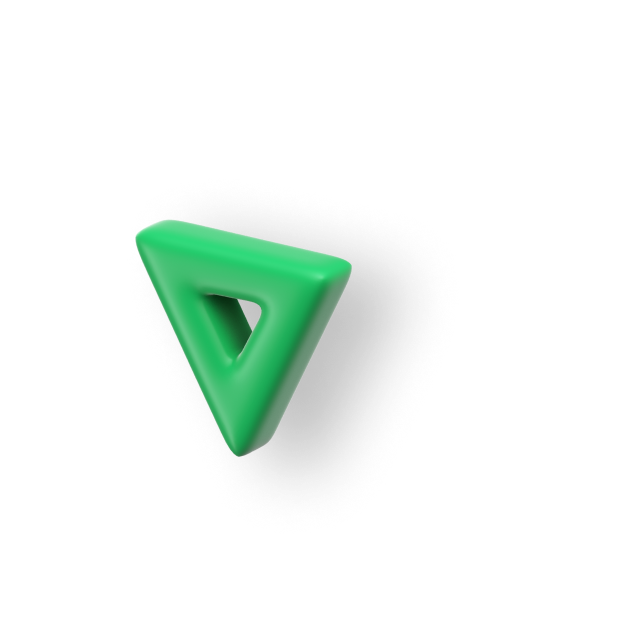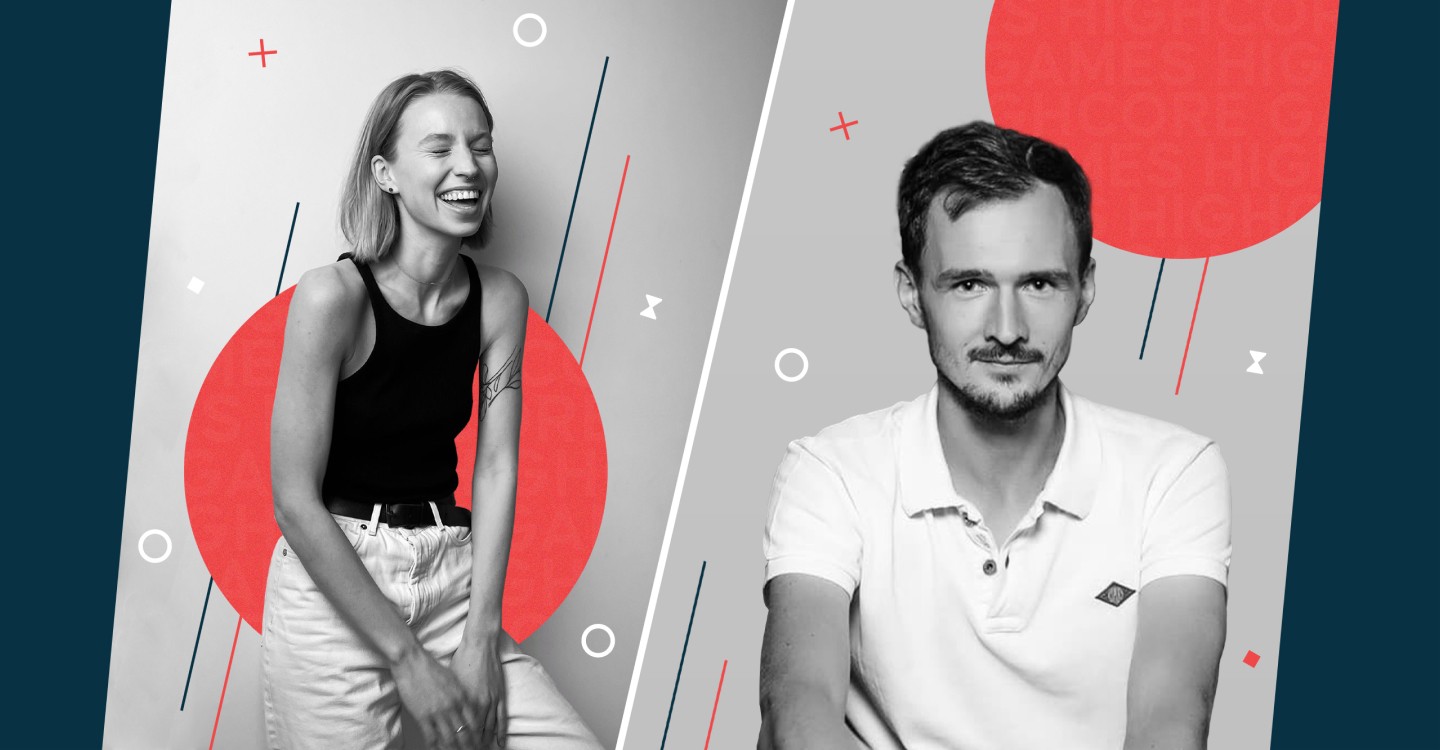



Vladimir and Alesya, motion designers at Highcore Games, answer questions about the profession, explain how design combines business and creativity, and explain how to avoid burnout at work.
💥 Who is a motion designer?
V: Motion means movement, so a motion designer is a designer of a moving image. Everything that is created on the computer, moving and changing over time is done by motion designers. Motion designers can be classified into categories: 2D, 3D, real-time, 2D/3D characters, and so on. The base of the working tools depends on the direction.
Motion designers have a common artistic and aesthetic base: they understand composition, color, volume, and form. There are also many intersections with directing, filmmaking, and even more so with animation. It is important for them to be able to place accents, work with sound, understand the tempo of the stage, and manage the audience’s attention. It is necessary to lead the viewer through one’s creation in order to solve a certain problem: a marketing or business problem.
💥 Why motion design?
A: It just happened – I used to work at different jobs, and I came to motion design. At first, I worked as an administrator in a restaurant in Minsk, then I got interested in web design, made pictures, logos, postcards, and then I was offered an internship at a big company. The job was kind of mechanical and boring – I left after my internship and decided to start drawing. I created an Instagram account, posted everything there, and people started ordering different pictures. I thought it would be great if the pictures moved.
Then I took a course in motion design, but I didn’t like the course, so I continued to publish drawings on Instagram.
Then, due to coronavirus, all the establishments in the city closed down. I decided to find a new job, so I spent half a year at home and mastered motion design. I decided to, and I found it.
💥 What is the difference between a motion designer and a simple designer, what can he/she do that the latter cannot do?
V: The notion of a «simple designer» doesn’t seem right to me. Any designer has a specialization, there are many of them, and each one is really profound.
There are graphic designers, web designers, product designers, industrial designers, interior designers, 2D/3d artists, layout designers, sound designers, and game designers. Each can be called a «simple designer,» but all they have in common is the word «designer» and sometimes the tools. Everyone solves specific problems. And every designer, experienced in their craft, is skilled and knowledgeable in many things that other designers don’t know. You can’t force one specialist to do different design – they’ll have to retrain or learn more. However, the base and tools can be the same. For example, almost all designers work in Photoshop or its analogues, but do different things. Motion designers also make commercials for games.
💥 What problem do they solve?
V: Motion designers solve problems here and now – they sell here and now. This is advertising in action: you entice, you keep, you pitch/sell the game as an interesting idea, you make people click/download it.
If a banner that says ‘GARAGE for sale’ in yellow letters on a red background will help sell a garage quickly, it’s a good design decision. If the entire red wall is painted with the inscription ‘GARAGE for sale’, then you need to stand out and look for other solutions. You can change the color, style, font, whatever. The goal is to sell here and now.
💥 So, design is more about business than creativity?
V: Designers are not artists, because they don’t create for the sake of creating. But motion designers can be artists: in Moscow, for example, there is the MARS Contemporary Art Center. But first of all, motion designers create to solve problems.
A: To me, design is not about business or money. A person chooses to go there, to work where they want to express themselves, to create something of their own, to visualize their experience, their knowledge. To share something of their own! Surely, from a company’s point of view, design means promotion, advertising, and money. But for a person, design means creativity.
💥 Why are commercials often not about the game, but about the game that one would like to see?
V: Commercials are different from games because you have to get the user interested in five seconds and convince them to click a link or download a game in twenty seconds. Try to cut any 25 seconds out of your favorite game so that it somehow reveals its essence. It’s safe to say that any 25 seconds of pure game play from Red Dead Redemption 2 do not reveal or sell the game: within 25 seconds you do not understand its strengths, how it is different from the competitors. But Red Dead Redemption 2 is a AAA game, and high-budget games compete with each other many times less than mobile games do. A game is a long-term experience, a narrative, a slow engagement, and a learning experience for the player. You cannot convey that in 25 seconds.
The commercials you bet heavily on often do not work. But if a commercial works and gets a lot of users, we develop it – we make different variations with small changes. And this is how we get top commercials that show better numbers. This is the Pareto principle in action: 20% of commercials bring in 80% of the audience.
💥 Do you click on commercials for other games?
A: I do, but not because I’m really interested in the game, I do it for work: I want to understand how other studios make commercials, I’m interested in their thinking, how they come up with their ideas – why this commercial is for one game and that for another one.
💥 Do you have to play the game all the time and look for interesting moments to come up with a gameplay commercial?
V: I don’t play our games regularly, because I don’t play on my phone in general. But I know our games well, because I play them when updates come out and read reports from our game designers and artists.
Besides, we have meetings where we watch cool videos, for example, successful videos by our competitors. At these meetings, we analyze why people watch these videos, what is so compelling about them, and how we can make the same thing for our games.
Sometimes you get ideas when you are making a video. I simply sit down and start thinking: I go through all the options for about 15 minutes, then I pick up one, write it out, lay it out over the scenes – and then another idea comes up. In an hour and a half I get from two to five scenarios. And if there are no ideas, you take someone else’s drafts, and off you go.
💥 Which of the studio’s games is your favorite and why?
A: I like Stealth Master because the picture is cool and bright, plus the gameplay is unpretentious. It’s not like in Tanks A Lot, you play as a little man and smash other ninjas. It would be fun to switch from tanks to humans, but so far I’ve only had one Stealth Master video, with this chubby funny ninja. I liked it.
💥 What do you like more – coming up with ideas or making videos?
A: Probably making videos, because that’s what creativity is. First of all, you build a scene, choose colors, model all kinds of details in the frame: rocks, branches, all sorts of things. And then you transfer it to the computer, and the picture comes to life.
And as for ideas, I like implementing other people’s ideas, rather than coming up with my own. Especially after a while you begin to understand what the idea is, how everything should appear, move, and look.
💥 How do you know if a commercial is bad? Is it that the team didn’t like it, you didn’t like it, or are there any objective points that make it cool?
V: There are objective flaws. For example, something doesn’t move right. Normally someone from the outside will look at it and give me a hint. Unless I like the video, I don’t submit it. There is no perfect formula, but there is a quantity and quality of clicks. However, there are times when a blatantly bad video works better. And this is not an ugly design, a trend in design, when you intentionally make it ugly, it’s just a badly made commercial.
In 2018 spring-summer collection, Gucci presented a crystal beard for women, and in late 2021 Balenciaga introduced new ugly Defender sneakers with triple tractor soles. In 2017, Dropbox decorated its website with multicolored collages, and Art. Lebedev Studio designed a funny logo for a Minsk bakery. Ugly design was formed, among other things, out of the ugly posters and pictures from the 1990s and 2000s – motley, with weird fonts, gradients, shadows or simply gigantic letters all over the sign. Ugly Design is art for the sake of art, not for the sake of a show. Good design is the one that works, and good ugly design works if it makes ugly things beautiful or interesting. – Ed. note
A: I don’t know what the answer is, because some good videos don’t work. Let’s say we’ve been making a video for three weeks, it’s all nice and cool, all the animations are good, and everything is nice and technically correct. But there are not many clicks on this nice video, and it is unclear why people don’t like it.
And then there are videos that are intentionally ugly, the so-called ugly design: the colors are grotesque, the movements are crooked, and everything is ludicrous. And people click on them, they watch them, and you don’t understand why you’re watching it for the tenth time. This is how it works.
💥 Are you going to be a motion designer permanently, or is it one of the steps on the job ladder?
V: Motion designer is a craftsman. If you improve your hard skills, you’ll become a super craftsman. If you master management and communication skills, you will become a team leader, a mentor, or an art director. It seems that there are only two steps, but they are available to the motion designers and not really available to the others. Next, you can become a producer, a project manager, I don’t know, a company director! Yet, they say you can get into leadership positions from the outside, you don’t have to be a super craftsman in motion.
To me, to manage means to build a system. You don’t have to know all the buttons in After Effects to do that, but you do need to know how to create and set up effective systems out of people. Like, finding specific specialists who solve specific problems, and balancing price and quality. It is important to understand what you rule, but not everyone wants and needs to rule. To each their own.
💥 Who came up with the idea of combining motion and design, who is the father or mother of motion design, and when did motion designers appear?
V: The idea of combining motion and design was invented long before computers. The lion screensaver from Tom and Jerry is a product of motion design. And someone designed the screensavers for the TV shows of your childhood or the TV commercials, right? The issue was that motion designers had nowhere else to work in the CIS except TV, but then the Internet developed and the labor market grew. I started studying design in 2007, and I made my first money in 2010. Like many other guys at that time, I learned about design from [motion designer and visual effects artist] Andrew Kramer: he had (and still has – Ed. note) a website called VIDEO copilot, where he posted the first clear, structured, instructional videos. He is an absolutely iconic figure who made a significant contribution to the development of the industry [if only because he taught design to tens of thousands of people].
💥 Why is it cool to be a motion designer, and why not?
V: Motion design is a creative craft. You either like it or not. If you want to create something out of nothing, it’s a good profession to try out and express yourself. Nobody is ever going to say, “You did too well, re-do it!” You can be great at anything, as long as you want to develop. Here’s a life story.
There was a girl, Masha, who worked in a studio, and she was churning out commercials like a robot. But Masha complained that none of the videos was suitable for the portfolio. Nevertheless, Masha earned 50% more than Dasha, who was making the most out of very trivial, typical commercials, and made them of premium quality. Six months later, Dasha was promoted, and Masha was still churning out like a robot. She’s still there now – and Dasha earns twice as much.
A: It is cool because it means new experience for me, new world – I’m creating videos that I haven’t done before. The coolest thing is that at first there is no video, and then you make it, you see the result, and you are happy and pleased that you did it! It’s cool to do new things, to do better than others.
What is not cool for me is to sit still, to sit in a chair. I lie down by the computer, then I half-lie down – any way I like, like a cat. Sometimes I crawl with the laptop on my lap. I’m not an office person at all, and being a designer is, after all, an assiduous job.
💥 Do you need a ritual to get in the mood for work – get some air, have some coffee, whatever – or do you just sit down at your computer and work?
V: I sit down and work. The hardest thing is to get started. For the first 10 minutes you force yourself to do something, and then you work automatically. Music helps to find the right tempo.
A: I start working at 2 p.m., but I get up early in the morning to do some surfing and get pretty tired. Because when I’m tired, I lie down, have a coffee, get in the mood to work – and I work. So, you have to exhaust yourself, right? Or just have a coffee?
💥 How to recover from burnout: to rest, to take your mind off things, not to play games?
V: It is very difficult to recover from burnout. It’s better to prevent it. Everything they say about work-life balance is true. I’ve learned to completely disconnect from work – if I close my laptop, that’s it, I’m a different person. Obviously, if there’s an emergency, I’ll step in. But if you plan it right, you won’t have to. After all, I cannot remember many cases when it was urgent for me to step in. Some people have to learn not to do that – not to mix work and life, not to think about work problems outside of work. And there’s no need to worry at work either: any problem can be solved.
A: I guess you have to wait it out. Just wait it out. Everyone needs a rest – to go somewhere that they won’t wish to come back from. In the end you will come back anyway, because it’s your job, but you will come back in a good working mood.
We are also preparing an article on how to use cameras in a scene, accents in the frame, and storytelling with camerawork techniques. Let’s keep in touch!
